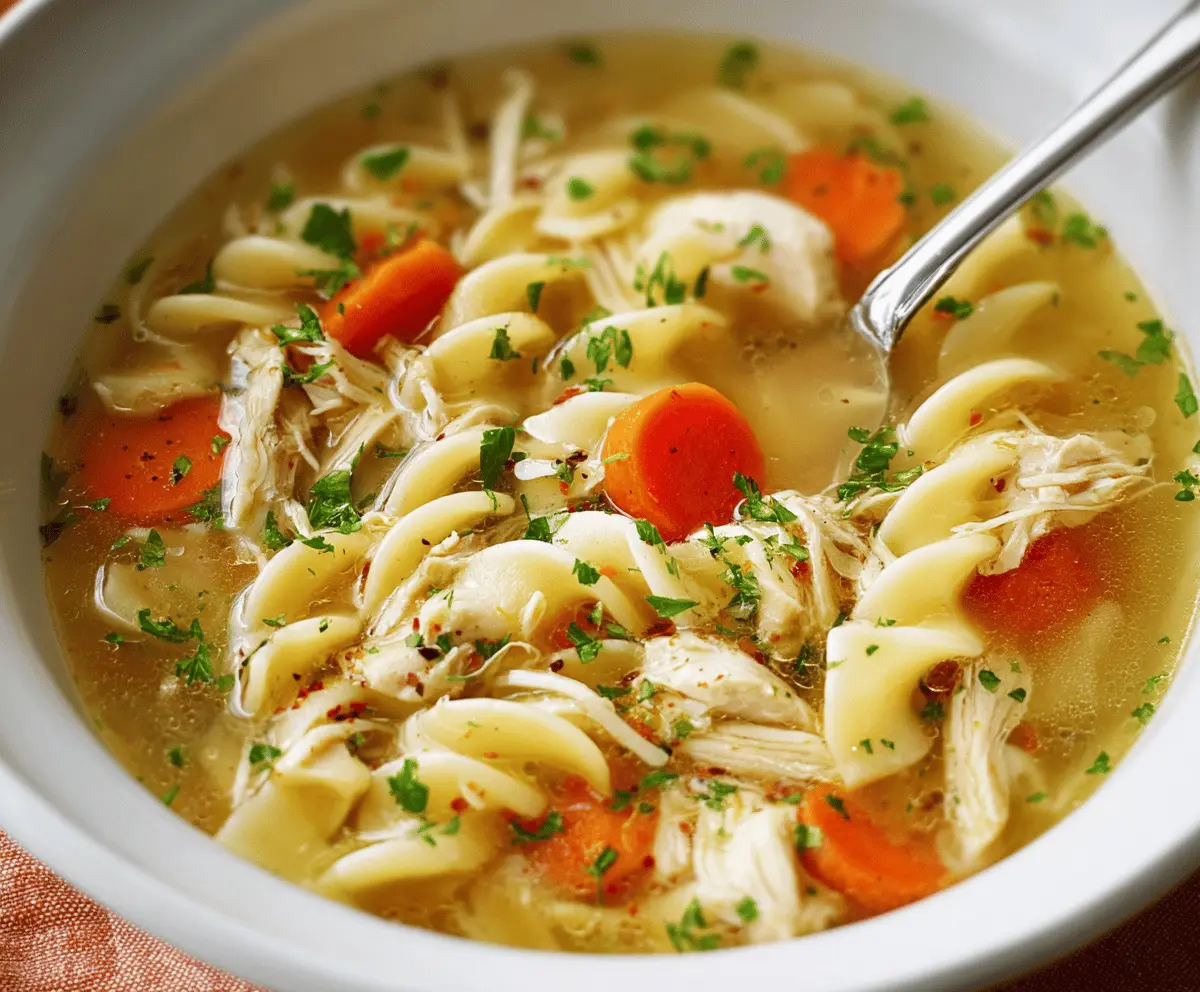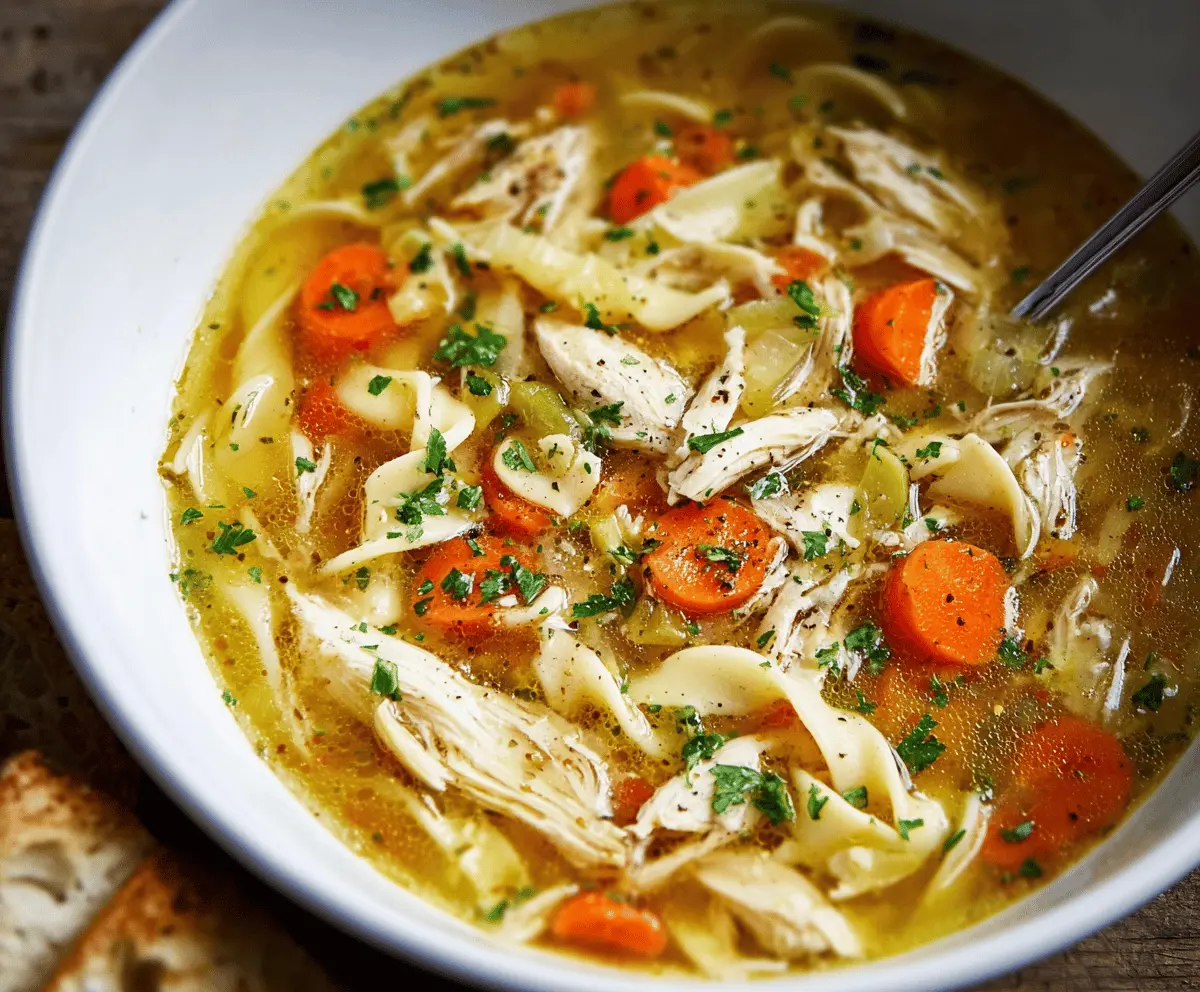Chicken Noodle Soup is a classic comfort food that’s warm, soothing, and full of simple, wholesome ingredients like tender chicken, soft noodles, and lots of fresh veggies. It’s the kind of soup that feels like a big, cozy hug on a cold day or when you’re feeling under the weather.
I love making this soup from scratch because the house fills with the smell of simmering herbs and gentle chicken broth. It’s easy to customize too—sometimes I toss in extra garlic or finish it off with a squeeze of lemon for a little brightness. I always find that homemade chicken noodle soup tastes better, probably because it’s made with a lot of love and a little extra patience.
One of my favorite ways to enjoy this soup is with a piece of crusty bread on the side for dipping. It’s perfect for sharing with family or friends when you want something simple yet nourishing. Plus, it’s a great way to use up leftover chicken, which makes it both tasty and practical in the kitchen.
Key Ingredients & Substitutions
Chicken broth: Using low-sodium broth gives you control over the saltiness. If homemade broth isn’t available, store-bought works fine. You can also add a bouillon cube if you like stronger flavor.
Chicken: I prefer cooked, shredded chicken breast for tenderness. Rotisserie chicken is a great shortcut. Turkey can be used if you want a different taste.
Vegetables: Onion, carrots, celery, and garlic create a classic flavor base. If you don’t have celery, extra carrots or leeks work well.
Noodles: Egg noodles are traditional and cook quickly. If you’re gluten-free, try rice noodles or gluten-free pasta. Add noodles at the end so they don’t overcook and get mushy.
Herbs: Thyme and parsley add fresh, earthy notes. Fresh herbs are great for garnish, but dried herbs work well for simmering in the soup.
How Do You Keep Noodles From Getting Mushy in Chicken Noodle Soup?
Noodles can easily turn mushy if cooked too long or if left in the hot soup before serving. Here are some tips to keep them just right:
- Cook noodles separately in boiling water, drain, and rinse briefly to stop cooking. Add them to the soup just before serving.
- If you cook noodles directly in the soup, add them at the very end and keep cooking time to minimum as per package directions.
- Leftover soup? Keep noodles separate until reheating. This keeps your soup fresh for later meals.
- Use wide egg noodles or sturdy pasta that holds up better with a bit of simmering.

Equipment You’ll Need
- Large pot or Dutch oven – perfect for simmering the soup evenly and holding all your ingredients comfortably.
- Wooden spoon – great for stirring without scratching your pot.
- Chef’s knife – makes chopping veggies quick and easy.
- Cutting board – protects your surfaces while prepping ingredients.
- Measuring cups and spoons – help you get the broth, herbs, and seasonings just right.
Flavor Variations & Add-Ins
- Swap chicken for cooked turkey for a twist after Thanksgiving; it adds a slightly different richness.
- Add diced potatoes or sweet potatoes for a heartier soup that’s extra filling.
- Stir in fresh ginger and a splash of soy sauce for an Asian-inspired flavor profile.
- Mix in spinach or kale near the end of cooking for a boost of green and nutrients.

How to Make Chicken Noodle Soup?
Ingredients You’ll Need:
- 1 tablespoon olive oil
- 1 medium onion, diced
- 2 medium carrots, sliced
- 2 celery stalks, sliced
- 3 garlic cloves, minced
- 8 cups chicken broth (preferably low sodium)
- 2 cups cooked chicken breast, shredded
- 2 cups egg noodles or wide egg pasta noodles
- 1 teaspoon dried thyme
- 1 teaspoon dried parsley (plus extra fresh parsley for garnish)
- Salt and black pepper, to taste
- Optional: fresh parsley, chopped for garnish
How Much Time Will You Need?
This soup takes about 15 minutes of prep and about 25 minutes to cook, including sautéing the vegetables, simmering the broth, and cooking the noodles. It’s a quick, comforting meal you can enjoy any day.
Step-by-Step Instructions:
1. Sauté the Vegetables:
Heat the olive oil in a large pot over medium heat. Add the diced onion, sliced carrots, and celery. Cook, stirring occasionally, until the vegetables are tender and soft, about 5 to 7 minutes.
2. Add Garlic and Broth:
Add the minced garlic to the pot and cook for another minute until fragrant. Pour in the chicken broth and bring everything to a boil.
3. Add Chicken and Herbs:
Stir in the shredded cooked chicken, dried thyme, and dried parsley. Reduce the heat to low and let it simmer for 10 minutes to blend all the flavors.
4. Cook the Noodles:
Add the noodles to the simmering soup. Cook according to the package instructions, usually 6 to 8 minutes, until they’re tender but not mushy.
5. Season and Serve:
Season the soup with salt and black pepper to your taste. Ladle the hot soup into bowls, garnish with chopped fresh parsley if you like, and enjoy it warm—maybe with some crusty bread on the side!
Can I Use Frozen Chicken in This Recipe?
Yes, you can! Just make sure the chicken is fully thawed before shredding and adding to the soup. Thaw in the fridge overnight or use the cold water method for quicker thawing.
Can I Make This Soup Ahead of Time?
Absolutely! The flavors often improve a day after making it. Store the soup (without noodles) in an airtight container in the fridge for up to 3 days. Add freshly cooked noodles before reheating to avoid mushiness.
What Can I Substitute for Egg Noodles?
If you don’t have egg noodles, try pasta shapes like rotini or orzo. For a gluten-free option, use rice noodles or gluten-free pasta and add them at the end of cooking.
How Do I Store Leftovers?
Keep leftovers in the fridge in a sealed container for up to 3 days. To reheat, warm gently on the stove or microwave. It’s best to add fresh noodles when reheating to keep them from getting soggy.


